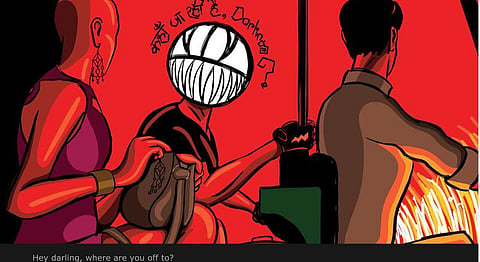
- HOMEGROWN WORLD
- #HGCREATORS
- #HGEXPLORE
- #HGVOICES
- #HGSHOP
- CAREERS
- ABOUT US
- CONTACT US

Claude Cahun, an androgynous surrealist artist of the 1930s, in her enigmatic autobiography, writes, “Under this mask, another mask; I will never finish removing all these faces.” Subverting gender conventions, Cahun recaptures the essential quality of genderqueer and fluid life. Cahun also details the daily performance of façade, that we all partake in. However, queer persons especially are made to be restricted. What really are notions of masculine and feminine? Who are we when we remove our classifications of gender?
Artist Shubham Bose Roy wonderfully explores their own queerness through vivid design and illustration. A gender-queer and trans-feminine individual, Roy and their art finds a sense of solace in the fluid intersections of life. Based in Delhi, their latest visual autobiographic illustration project Sediments has eclectically captured the inertia of identity. Inside the landscapes of, an unsafe stigmatizing society, one’s own mind, projections of lust, intimacy and the haunting residue of childhood. Roy describes it as, “a visual autobiographic art project, based in erotica and self-portraiture. It’s a series of 100+ artworks in a singular semi-linear narrative, experimenting with illustration, graphic design and typography, in English, Hindi and Bangla.”
On sexuality, Roy retells their personal history, “sexuality has always played a central role in my art of self-expression. During my formative years, I had always been a bit disappointed with the dearth of a more nuanced exploration of gender in the erotica I could find. I never saw myself in the imaginative fantasy of the bodies I saw, so I decided perhaps I should render a body which could perhaps aspire to draw the abstraction of an indefinite gender I experienced in my life.”
‘Sediments’ transverses language as well. Using Hindi, English and Bangla, Roy cultivates an incredibly close and honest portrayal of abstract identity. Experimenting with different styles throughout the comic, the typography pops and pulls you in and says ‘look’. The semi-linear narrative envisioned by Roy curves and deep dives further into subliminal loneliness, of the self, and of connection. Roy posits their reasons for necessitating the comic to be multilingual, “I wanted to document all kinds of messages that were communicated to me via various modes, verbal or textual. So, it was imperative to record them in the languages I received them in. There are so many cultural contexts and semantic implications that are limited to every specific language and gets lost or diluted in translation.” They also reiterate the pitfalls of binary language, “For instance, the academic urbanness of spoken English and the patriarchal aggression embedded within Hindi are not interchangeable for me.” On Bengali heritage, Roy says, “Bengali was the first language with which my sense of identity began to take shape throughout my childhood. So, in order to call ‘Sediments’ my autobiographic documentation, it was important to preserve the impact language has had over my sense of self as a Bengali queer and trans-feminine individual, born and raised in South Delhi.”
About their influences, Roy says, “Growing up in a Bengali household, Jamini Roy’s modernism was inescapable, and I can’t deny the fact that it played a foundational role in my foray into art and design. In fact, I also wanted to explore how dysfunction and discomfort could be communicated through the same stylisation, which otherwise is presumed to be pleasing to the mind. Besides that, the cyclops corridor at the hotel is my hat tip to Beyoncé’s music video for ‘6 Inch’.”
Roy also comments on their dark red, doomsday-esque, colour-sequence in the comic strip, “the bikers accosting my auto-ride in the flashback sequence, the stylisation of their faces are a direct allusion to a famous antagonist character from Marvel series. While I admit that it is a bit cheeky in its obviousness, I must point out that my attention was always drawn to the concept of Venom— an entity that can possess and control a physical body, and brings forth the darkest, ugliest aspect of its mind — similar to how toxic cis-masculinity at large feels entitled to manifest its the most vicious and ugliest form at the sight of transfeminine bodies”
The meaning of art varies from person to person and artist to artist. Being queer in a largely heteronormative system comes with more than a few qualms. Roy reiterates what queerness and art mean to them, “I believe there would be as many meanings as there are instances of queerness in human lives. For me personally, being queer means, this constant, endless and exhausting struggle to find and reinforce a sense of belonging, every breathing moment of my life. Even while walking down any path, to be constantly reminded that I’m ‘different’, it takes a continuous effort to contain that self-awareness from spiralling into a whirlpool of anxiety and dysphoria, just so that I don’t waver from staking my rightful claim to my existence in this world and assert that I belong here. I guess, I can say that my art to emanates from a similar endeavour— to leave behind a testimonial, that I existed; and paint a picture of what this world looked like from my eyes, while I did.”
You can view Shubham’s entire art project here.
If you enjoyed this article, we suggest you read:
